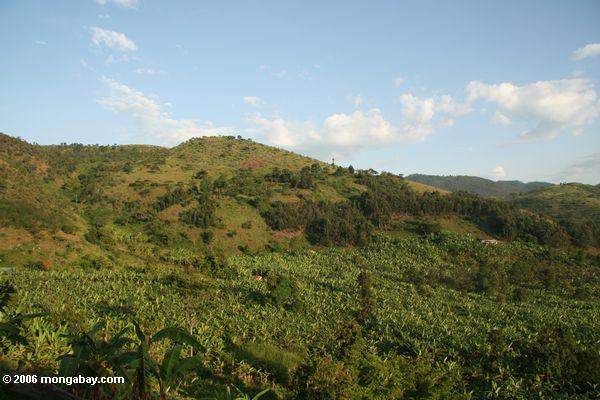An interview with Brian Machovina, a part of our on-going Interviews with Young Scientists series.

Brian Machovina and one of his drones, which he flew over banana plantations to study stressors and productivity. Photo by Brian Machovina.
Not many students in their final year of a PhD program are running press events in Europe for an ice cream-making machine. When I caught up with Brian Machovina he was still jet-lagged from the latest product launch of “Yonanas” in Germany, and girding himself for a return to his desk and his due-in-six-months dissertation.
The press trip might sound like a diversion from Machovina’s studies on the impact of personal food choices on global conservation. But in Machovina’s life, the serendipitous influence of people and places have all contributed to his current passion for inspiring people to eat less meat. With fewer grazing animals, Machovina’s studies show that we could make better conservation and production choices with the additional land available.
Machovina’s conservation plan, “90P,” is based on getting 90 percent of our daily calories from plants instead of meat.
“It’s the culmination of my last few years of research, a long job history in the natural products field, and working in conservation,” he says. “In the last couple of years I’ve realized how much of an effect that consuming animal products has on personal health and environmental health.”
“It’s the number one thing that an average person around the world can do to reduce climate change, affect biodiversity, and protect their own health: Just eat less animal products and eat more plants,” he says.
Machovina’s path to 90P was anything but straight. Although he started his academic career on the traditional academic track, earning his undergraduate and master’s degrees at Florida International University in Miami, other opportunities called during his first crack at a doctorate. And even though Machovina is in his forties, he is just embarking on what looks like an already impressive science career.
“You could say I chose a particularly long program,” Machovina says with a laugh. “I’m flattered to be considered part of the ‘young scientist’ series because I have some grey at my temples and I’m in my early forties. But I intend to finish my PhD by the end of this year.”
AN INTERVIEW WITH BRIAN MACHOVINA
Mongabay: You have an unusually entrepreneurial backstory for a PhD candidate in agroeconomy. But, first, I’ve got to ask: What is Yonanas?
Brian Machovina: It’s a machine that makes ice cream out of fruit. You take a bunch of bananas and get ‘em nice and ripe and spotted. Then you peel them and stick them in the freezer. Once the bananas are frozen, you run them in the machine along with other fruits, nuts, chocolates, or whatever else you want. When it comes out, it looks, tastes, and feels just like soft serve ice cream, but it’s made only from fruits.

The Yonanas machine, which Machovino developed. Photo by Brian Machovina.
Mongabay: Marketing an ice cream machine seems like a long way from studying the impacts of global meat consumption on conservation and land use.
Brian Machovina: It’s been an eclectic journey, for sure.
I was about three years into my doctorate degree when a friend called me with an amazing opportunity. I’d met this friend through a program we’d done as undergraduates, called Amigos de las Americas. It’s like a mini-Peace Corps, where you go for just two months. We were stationed in Costa Rica, doing school renovations near a little beach that was famous for its sea turtle nesting sites. So I just fell in love with that place.
When the program ended I moved back to Miami, but my friend stayed down there and started an expedition company. One of his clients was Woody Harrelson, the actor, and he wanted to protect the rainforest. So my friend contacted me and asked if my wife and I wanted to go to Los Angeles and start a rainforest foundation with Woody.
Mongabay: Was it a hard choice to make?
Brian Machovina: It was tough to leave a degree program and go on a tangent. But it seemed adventurous and it also seemed like I’d learn a lot. Woody put in a big chunk of money into establishing the Oasis Preserve International. And we had a fantastic board of directors: we had Joel Stewart, the captain of Greenpeace’s Rainbow Warrior, and Ted Turner’s foundation was also on our board. So, at a young age, I was really well connected in the conservation field.
 An olive ridley sea turtle (Lepidochelys olivacea) returns to the sea after laying its eggs on a beach near Ostional, Costa Rica. “On two occasions, at night, I saw 20,000 – 30,000 come to shore and nest,” Machovina said. Photo by Brian Machovina. |
Mongabay: Why did you move on?
Brian Machovina: We were in there about two-and-a-half years when Woody decided to fold the foundation into more of a private organization. So one night, my wife and I were at his (Woody’s) oxygen/raw food bar, in Hollywood over by Sunset Strip, and a couple of guys approached us. Really interesting characters; two brothers, who started Guayaki Sustainable Rainforest Products.
You’ve heard of yerba mate? We started with them when they were still selling the stuff out of Ziploc bags. My wife happened to be in marketing and sales and we helped build that company over the next four years. It really taught us about the power of using markets to drive conservation.
After about four years of that, I met Christopher Daugherty, who worked for a company called Essential Living Foods. I became one of his partners and we imported all kinds of organic natural foods – mainly from Latin America – everything from olives and pecans to herbs extracted from the rainforest. We worked with local farmers and local indigenous groups to harvest properly and drive reforestation efforts.
Mongabay: And then you took a sidestep away from natural product markets?
Brian Machovina: I did a little stint as the executive director of the California Coastkeeper Alliance, (a coalition of environmental advocacy organizations formed to prevent water pollution and promote kelp reforestation). I lobbied in Sacramento and Washington, DC. I filed lawsuits against cities that were polluting.
But my wife and I wanted to try our hand at starting our own business. So we spent four years building up Nui, a company we developed to instill ecological consciousness in youth. We launched it with a health beverage for kids. I also wrote the first book in a series of eco-adventures for kids. In the stories, kids lived on Nui Island and solved ecological problems that saved the day. It was one of my favorite things that I’ve done.

The children’s book Machovino authored for Nui, the company founded by Machovina and his wife.
Then came September of 2008. The markets crashed and all the money disappeared. We were in the middle of a whole business expansion and suddenly we couldn’t get anything from anybody. We lost our life savings. We lost our house. It was a very challenging time in the lessons of being an entrepreneur.
But at that point we didn’t have anything else to lose, so we brought an idea back to the table that we thought of a long time ago, back in the “Woody days” when we were in California eating lots of healthy foods…like ice cream made out of frozen fruits. So we sat down and started putting together a business around this machine we call Yonanas.
We ran a test infomercial with the machine and it went off the charts. Dole approached us and became an equity partner in the business. Now we’ve got Yonanas in about 60 countries and we’re developing commercial machines that are going into universities and hospitals.
Mongabay: So why go back to school after Yonanas started to really take off?
Brian Machovina: As the company started getting successful, I saw the potential to really drive demand for bananas. I knew that bananas had a pretty heavy ecological footprint. So I thought I’d go back to school and study the effect of bananas on the environment.
I did a study on climate change and saw how that’s going to affect areas where bananas are grown in the future. In about the 2060s, it looks like it’s gonna be a drastic change, especially in Latin America where most of the commercial growing exists. It’s going to get hotter and drier. Some of the large producing countries like Colombia and Costa Rica will be significantly affected according to models that we developed.

Machovina and his wife, Eileen, with Woody Harrelson, Courtney Love, Joel Stewart, and others at a Los Angeles fundraiser for Harrelson’s foundation, Oasis International. Photo by Brian Machovina.
I’m also developing a project for the Dole Food Company, flying drones over their banana plantations in Costa Rica. We’re using vegetation cameras to get a bird’s eye view of productivity patterns. Potentially we can use technology to identify and prevent stressors on bananas. Then if we can increase yields from existing plantations, they don’t have to expand.
Mongabay: If those drones don’t show increased yields, then won’t there be bigger plantations?
Brian Machovina: Yeah, that’s a potential. But I think there’s opportunity to not expand into any existing primary forest anywhere in the world if we can decrease animal product consumption.
Costa Rica, for example, is the number two exporter of bananas in the world. It has about 40,000 hectares of bananas, but about 2.2 million hectares of cattle pasture. So there are 55 times more cattle pasture than banana plantations. Cattle pasture takes up 44 percent of the area of Costa Rica in a country revered for its conservation efforts.
So there’s an opportunity, if plantations do expand, to say let’s take over some cattle pasture instead of forest. If people reduce meat consumption, they can use that pasture to produce biofuels, or revert it back to natural forest, because all that cattle pasture in Costa Rica was cut from primary forest.
A banana plantation in Uganda. Photo by Rhett A. Butler.
Mongabay: You’ve recently published letters about the threat that meat eating poses to tropical ecosystems in a spate of journals.
Brian Machovina: Developed countries have very high levels of meat consumption. In the U.S., almost 48 percent of calories come from animal products. This is just a staggering amount of consumption and it requires a much greater amount of area to produce animal products than it does to produce plant-based products.
If you look at a lot of the developing countries, they have low but rapidly increasing numbers. So China, for example, which harbors more than 20 percent of all the people on the Earth, was at a level of 10 percent consumption of animal products on a caloric basis up until the 1980s. Now they’re at a 20 percent level basis. And in the next 30 years they are projected to get up to 30 percent. If they continue on that trajectory, they’ll reach the level of the United States, and the footprint of that development is staggering.
I’m working on a paper on the effects of that per capita meat consumption, specifically in the tropical world, and how that will affect the forests in those areas in the future. And it looks like it’s going to have a pretty significant impact.
Mongabay: So what does your dissertation focus on?
Brian Machovina: It’s actually a four-part project. One part is a banana modeling paper, looking at how climate change is going to affect export banana plantations in the future. Another part is about using drones to potentially increase yields on existing banana plantations. The third part examines the effect of increasing projected meat consumption on biodiversity, especially in these tropical megadiverse countries. And the fourth part, a paper I’m working on right now, is examining the tradeoff between meat production and biofuel production in grasslands around the world.
I say, that in our entire world, we should eat no more than 10 percent of our calories from animal products and 90 percent should come from plant-based products. That would open up an enormous amount of area around the world for other uses.
One of those uses could potentially be for planting biofuels; specifically developing high biodiversity, low input grasslands. So, basically, bringing back the grasslands that historically existed but utilizing that grass to produce biofuels, and then looking at comparisons across the countries and the ability of those countries to meet their fuel needs.

Amazon rainforest. Photo by Brian Machovina.
Mongabay: What will you do with all your work when you’re done?
Brian Machovina: I really like entrepreneurial adventures, but the next route I see myself going down is promoting “90P.” It’s about inspiring and educating people to eat about 90 percent of their calories from plant-based products.
As I delved into world of tropical agriculture, I started seeing the general effects of agriculture. It led me down the road of realizing how much impact choosing the kinds of foods you eat has on the environment.
And it goes back to Woody Harrelson. He was a vegan for a lot of reasons, but one of them was for environmental reasons. At the time I didn’t quite grasp all the nuances or the scientific basis behind them. It’s really opened my eyes.
Mongabay: So, that begs the question, how long have you been a vegetarian?
Brian Machovina: I’m not 100 percent vegetarian. I’m probably a “95P.”
I think getting people to realize that you can improve your own health, and the health of the world, without having to give up something you love has a much better chance of succeeding than getting people to go completely vegetarian.
Mongabay: What has been your inspiration on this eclectic journey?
Brian Machovina: I would say it’s nature itself. I made trips to the tropics when I was a freshman undergraduate. For Spring Break a buddy of mine and I decided to go to the Amazon – not a typical choice way back in 1989. And I still remember flying for hours over this endless expanse of green and I thought it was the most amazing thing I had ever seen. That trip inspired me to go back and do the Amigos work, which led to work with Woody. So I would say it was the spectacular inspiration of nature that has always driven me.

A photo from Machovina’s spring break trip in 1989. “From my first trip to the tropics – Leticia, Colombia – for spring break my freshman year in 1989. The one of the kids is my favorite from the trip. That moment really summed up how different my life was as a kid from what these kids were doing. I was enchanted,” he said. Photo by Brian Machovina.
Mongabay: Any advice to students coming up the academic ranks?
Brian Machovina: I get this question a lot because most of the students in my cohort are a lot younger than me!
I think its very important for students to diversify their knowledge base and their experience base. Speaking multiple languages can help. Understanding law is also really important if you want to get in the conservation world.
But one of the things that probably benefitted me the most was learning about finance and how to speak the language of money. It’s really important because money drives everything, whether it’s conservation efforts, fundraising, business development, or government jobs. And knowing the world of business is really important for conservation because it’s big business that destroys a lot of the habitat.
Citations:
- Feeley KJ and Machovina B. 2014. Letter: Increasing preference for beef magnifies human impact on world’s food web. Proceedings of the National Academy of Sciences USA. 111, E794-E794.
- Machovina, B and Feely KJ. 2014. Letter: Meat consumption as a key impact on tropical nature: a response to Laurance et al. Trends in Ecology & Evolution, pp. 430-431, August 2014
- Machovina, B and Feeley KJ. 2014. Correspondence: Taking a bite out of biodiversity. Science. 343(6173): 838.
- Machovina, B and Feeley KJ. 2014. Correspondence: Livestock: limit red meat consumption. Nature 508: 186.
Related articles
Tapirs, drug-trafficking, and eco-police: practicing conservation amidst chaos in Nicaragua
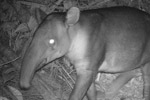
(10/10/2013) Nicaragua is a nation still suffering from deep poverty, a free-flowing drug trade, and festering war-wounds after decades of internecine fighting. However, like any country that has been largely defined by its conflicts, Nicaragua possesses surprises that overturn conventional wisdom. Not the least of which is that the Central American country is still home to big, stunning species, including jaguars, giant anteaters, pumas, and the nation’s heaviest animal, the Baird’s tapir (Tapirus bairdii). Still, not surprisingly given the nation’s instability, most conservationists have avoided Nicaragua. But tapir-expert Christopher Jordan, who has worked in the country for over four years, says he wouldn’t have it any other way.
Bornean elephant meets palm oil: saving the world’s smallest pachyderm in a fractured landscape
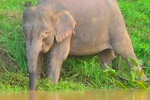
(10/01/2013) In the Malaysian state of Sabah, where most conservation students are still foreigners—either European or American—Nurzahafarina Othman stands out: not only is she Malaysian, a Muslim, and a mother of a young daughter, but she’s rapidly becoming a top researcher and champion for the world’s smallest elephant: the Bornean elephant (Elephas maximus borneensis). Although sometimes described as a pygmy elephant, they still weigh 2,000 kilograms (4,400 pounds). The origin of these ‘tiny’ elephants in Malaysian Borneo have baffled scientists for decades.
Mercury hurts birds and people: what we can learn from studying our feathered friends
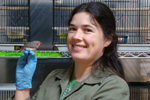
(01/07/2013) Birds aren’t that different from people. We learn from our parents, just like zebra finches learn songs from their fathers. We are active and noisy during the day, like birds, and we can also be territorial. Also like birds, we try to attract mates through colorful displays and beautiful songs. Birds are sensitive to pollution in their environment just like we are: harmful elements such as mercury wreak similar havoc on human and bird biology alike. Because our species share so many attributes, studying birds illustrates the connections between them and us.
Forests, farming, and sprawl: the struggle over land in an Amazonian metropolis
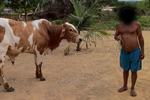
(12/04/2012) The city of Parauapebas, Brazil is booming: built over the remains of the Amazon rainforest, the metropolis has grown 75-fold in less than 25 years, from 2,000 people upwards of 150,000. But little time for urban planning and both a spatial and mental distance from the federal government has created a frontier town where small-scale farmers struggle to survive against racing sprawl, legal and illegal mining, and a lack of investment in environmental protection. Forests, biodiversity, and subsistence farmers have all suffered under the battle for land. In this, Parauapebas may represent a microcosm both of Brazil’s ongoing problems (social inequality, environmental degradation, and deforestation) and opportunity (poverty alleviation, reforestation, and environmental enforcement).
Vampire and bird frogs: discovering new amphibians in Southeast Asia’s threatened forests
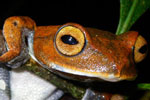
(02/06/2012) In 2009 researchers discovered 19,232 species new to science, most of these were plants and insects, but 148 were amphibians. Even as amphibians face unprecedented challenges—habitat loss, pollution, overharvesting, climate change, and a lethal disease called chytridiomycosis that has pushed a number of species to extinction—new amphibians are still being uncovered at surprising rates. One of the major hotspots for finding new amphibians is the dwindling tropical forests of Southeast Asia.
How lemurs fight climate change
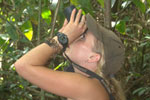
(01/09/2012) Kara Moses may have never become a biologist if not for a coin toss. The coin, which came up heads and decided Moses’ direction in college, has led her on a sinuous path from studying lemurs in captivity to environmental writing, and back to lemurs, only this time tracking them in their natural habitat. Her recent research on ruffed lemurs is attracting attention for documenting the seed dispersal capabilities of Critically Endangered ruffed lemurs as well as theorizing connections between Madagascar’s lemurs and the carbon storage capacity of its forests. Focusing on the black-and-white ruffed lemur’s (Varecia variegata) ecological role as a seed disperser—animals that play a major role in spreading a plant’s seeds far-and-wide—Moses suggests that not only do the lemurs disperse key tree species, but they could be instrumental in dispersing big species that store large amounts of carbon.
- Machovina, B and Feely KJ. 2014. Letter: Meat consumption as a key impact on tropical nature: a response to Laurance et al. Trends in Ecology & Evolution, pp. 430-431, August 2014
